The AMD Radeon RX 5600 XT Review, Feat. Sapphire Pulse: A New Challenger For Mainstream Gaming
by Ryan Smith on January 21, 2020 9:01 AM ESTPower, Temperatures, & Noise
Last, but not least of course, is our look at power, temperatures, and noise levels. While a high performing card is good in its own right, an excellent card can deliver great performance while also keeping power consumption and the resulting noise levels in check.
| Radeon Video Card Voltages | |||||
| 5600 XT Max | 5700 Max | 5600 XT Idle | 5700 Idle | ||
| 0.977v | 1.025v | 0.775v | 0.775v | ||
Interestingly, even with the BIOS update and AMD’s voltage-frequency curve extension, the voltages being used by our Sapphire Radeon RX 5600 XT are quite tame. The card never goes higher than 0.977v, which is almost 0.05v lower than the Radeon RX 5700, itself already a good deal lower than the full-fat Navi 10-based Radeon RX 5700 XT. While third-tier cards like the RX 5600 XT are uncommon, when we do see them they are normally running higher voltage (leakier) parts, and this is what I was expecting for AMD’s new part.
No wonder AMD is talking up the power efficiency of the card; even with its restricted clockspeeds, not going above 1.0v helps to ensure that power efficiency doesn’t take a dive by paying a massive power penalty to access the last few MHz worth of headroom.
| Radeon Video Card Average Clockspeeds (Rounded to the Nearest 10MHz) |
||||
| Game | Sapphire 5600 XT (Perf) | 5600 XT | 5700 | |
| Max Boost Clock | 1760MHz | 1670MHz | 1750MHz | |
| Official Game Clock | 1615MHz | 1375MHz | 1625MHz | |
| Tomb Raider | 1700MHz | 1610MHz | 1680MHz | |
| F1 2019 | 1700MHz | 1610MHz | 1650MHz | |
| Assassin's Creed | 1700MHz | 1660MHz | 1700MHz | |
| Metro Exodus | 1700MHz | 1600MHz | 1640MHz | |
| Strange Brigade | 1740MHz | 1660MHz | 1660MHz | |
| Total War: TK | 1740MHz | 1660MHz | 1690MHz | |
| The Division 2 | 1700MHz | 1610MHz | 1630MHz | |
| Grand Theft Auto V | 1720MHz | 1640MHz | 1690MHz | |
| Forza Horizon 4 | 1730MHz | 1650MHz | 1700MHz | |
Shifting over to clockspeeds, things look very good for the RX 5600 XT. The card’s clockspeeds are remarkably consistent, and this comes down to the fact that the card is rarely ever entirely power-bound. Rather, the card is running out of room on the voltage-frequency curve, making it very easy to get close to its peak clockspeeds in the process. This goes hand-in-hand with the relatively low voltage, allowing the card to run rather efficiently and avoid heavier power throttling.
Unsurprisingly, the card is closer to its peak when running at AMD’s reference clockspeeds than it is the default factory overclocked mode. Still, the latter sees the card average clockspeeds higher than the RX 5700, underscoring how these factory overclocked cards are primed to hit high clockspeeds, and that it’s going to be the lack of memory bandwidth that ultimately keeps them chasing the RX 5700.

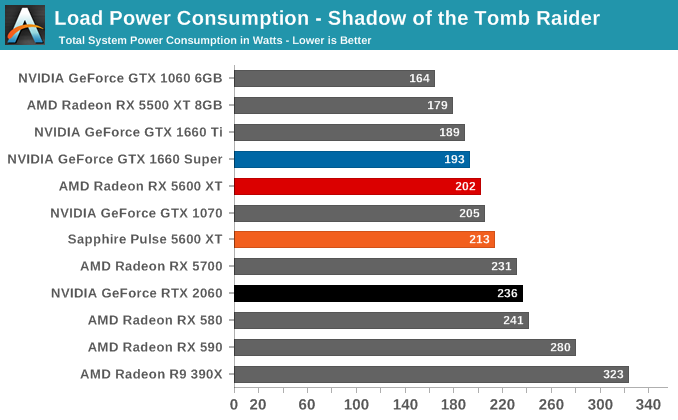
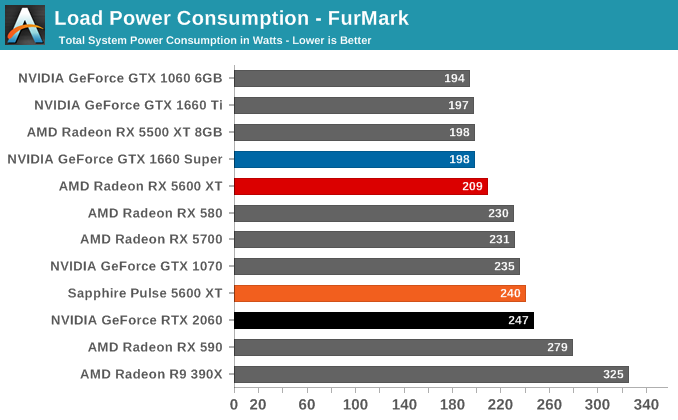
Taking a look at power consumption, we again find a good showing from Sapphire and AMD. The card’s idle power consumption shaves off a couple of watts at the wall relative to the RX 5700, thanks to the lower amount of VRAM and fully idled fans.
Meanwhile load power consumption also fares comparatively well. At reference clocks, we see AMD’s claims of higher power efficiency first-hand; measured at the wall, the card draws around 30W less than the RX 5700. Equally important, this keeps it relatively close to the GeForce GTX 1660 series. And while the RX 5600 XT ultimately ends up drawing more power, as we’ve seen it also handily outperforms those cards.
Sapphire factory overclock, however, is both a curse and a blessing. The blessing is that it improves the card’s performance to RTX 2060-levels, but the curse is that it does so while pushing power consumption to near RX 5700-levels. So when running at full tilt, the Pulse RX 5600 XT is less power efficient than the RX 5700, owing to its overall lower performance. Then again, it’s not like NVIDIA was doing very well to begin with. As a result, even when factory overclocked, the Pulse ends up drawing a bit less power than the nearest NVIDIA card.
I will also quickly note that the delta in power consumption between FurMark and Tomb Raider is higher for the RX 5600 XT than we’ve seen it in other Navi cards. All told, even at 1440p with the highest available settings, Tomb Raider is having a hard time keeping the RX 5600 XT busy enough that the card is running at maximum clockspeeds. This has made Tomb Raider turn into something of a best case scenario, as the card gets to idle a little bit.
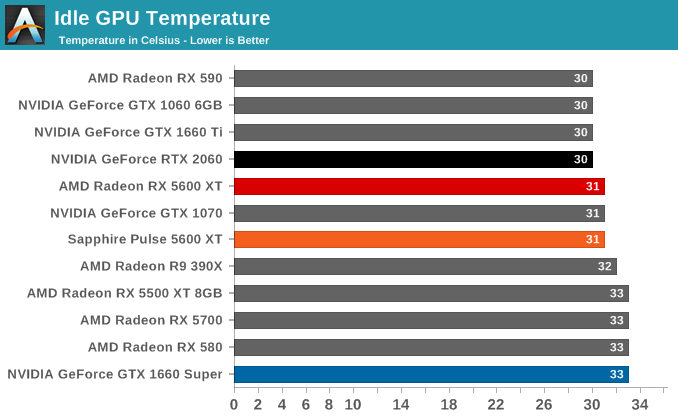
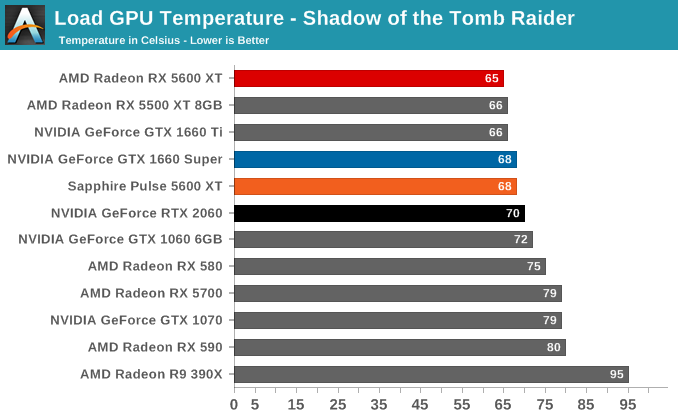

Moving on to temperatures, the large card has no problem cooling itself. In quiet mode the card never passes 68C, and even in full-on performance mode, the temperature maxes out at 74C. From a temperature perspective, Sapphire seems to have just about perfectly tuned the card’s cooler.
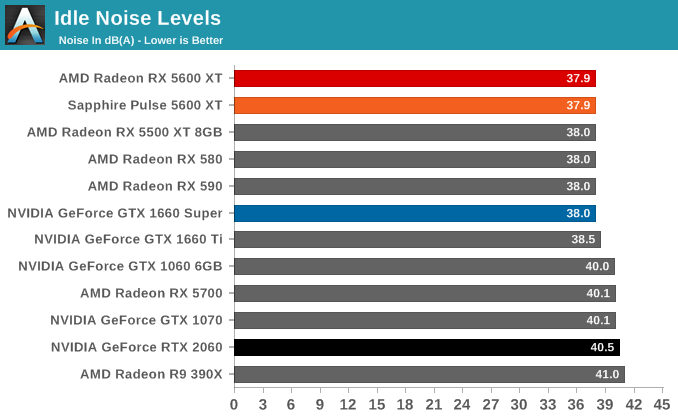
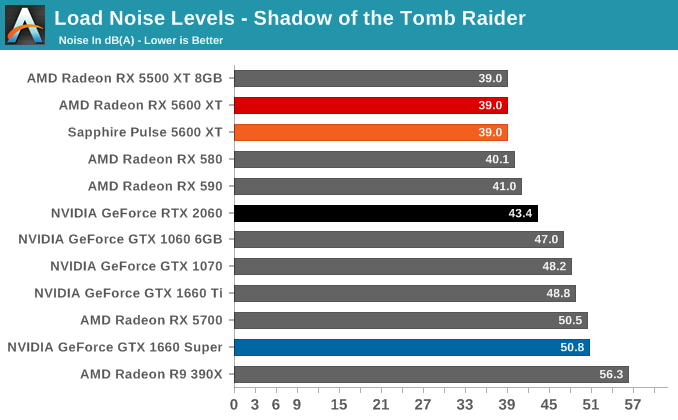

Finally, with noise, we get a chance to see how quietly the oversized Pulse can operate. And the answer is “very quietly”. At idle the card is entirely silent, thanks to its zero fan speed idle mode. Meanwhile with the quiet mode BIOS clocked at AMD’s reference clockspeeds, the fans only have to go to the card’s bare minimum fan speed – 25 percent – to keep the card cool, even under FurMark. To put this in context, we’re looking at a 150W card that’s having all of its cooling needs being met by a pair of fans running at a mere 750 RPM, which is a fraction of what they can actually run at.
Even with the factory overclock active, the cooler has no problem keeping up. Load noise for the 180W mode peaks at 41.2dB(A), which is close to silent and a great result overall. So for as much ribbing as I give Sapphire for the somewhat absurd size of the card, there’s no arguing with the effectiveness of the cooler. It’s quieter than almost every other card in this chart, including the GeForce GTX 1660 series cards and NVIDIA’s own reference RTX 2060.










202 Comments
View All Comments
Korguz - Friday, January 24, 2020 - link
more hare from cmdrmonkey....sorry man.. but nvidias drivers.. arent as perfect as your anti amd bias thinks
Korguz - Friday, January 24, 2020 - link
hare = hateSpunjji - Thursday, January 30, 2020 - link
If argument fails due to blatant dishonesty then redirect to boilerplate FUD.Farewell, goalposts; I hardly knew ye.
desmonds99 - Thursday, January 23, 2020 - link
AMD just overclocked the card themselves so reviewers would use this as a baseline to compare with other non-oc cards, making the card more appealing instead of DOA at $279. Once other cards are overclocked the price/perf will be the same as its competitors. AMD is just filling the gap for their lineup. $249 would be a more competitive price imo.Yojimbo - Monday, January 27, 2020 - link
Yeah. There was too much trust by reviewers on this situation. Some warning lights should have gone off. I don't know if it happened due to worry about access or if reviewers have something personal at stake.Will a buyer be able to flash? Will he get 14 Gbps memory if he does? Will the card have reduced reliability after the flash? And the problem doesn't go away after launch. 6 months from now someone can read this review thinking it is representative of the 5600 XT when there are cards out there that run over 10% slower. So what is the true price point of the cards that you can get that are validated to run at the benchmarked performance levels? Of course there will be a delta in the market, whether it becomes 160 to 180 or 180 to 200. That can give a completely different conclusion about the card, even ignoring the Busch league je-jiggering and the confusion it creates.
PProchnow - Monday, January 27, 2020 - link
The 5700XT is cranking over 2000Mhz and it is about tie AMD does this simple trick to make the GPU put out a little more.In this highly affluent world NO ONE will want a 5600XT unless they are little teenage paper route boys in high crime areas. $100 above the 5600XT lies a top end competitive card.
I understand these manufactures get a few lesser cores from the GPU chip foundary and pop them in the second tier cards that are $100 less than the GOLDEN SAMPLE GPU cards.
That is about all I need to know.
I do it on a GTX1080 and a R9 Fury clocked to 1100Mhz with more RAM bandwidth than the GTX [RTX?} ---- both plans to perform wotk. I hope for more HBM ram to get tied into the priemier performance video card. How could that tech turn into a side stepable meadow pie? Shame!
Yojimbo - Tuesday, January 28, 2020 - link
It's expensive. The fact that AMD needed to use it is one reason their high end cards were not very competitive. Maybe eventually its cost will come down. It is a very important technology in the HPC segments where bandwidth is a lot more important, though, so it's not a meadow pie.Spunjji - Thursday, January 30, 2020 - link
"In this highly affluent world NO ONE will want a 5600XT unless they are little teenage paper route boys in high crime areas. $100 above the 5600XT lies a top end competitive card."I'mma guess that you're the sort of person who laughs when someone says "check your privilege"...
Yojimbo - Thursday, January 30, 2020 - link
Since when are people talking about financial situations when they say "check your privilege"?PProchnow - Friday, February 7, 2020 - link
Gimme BIG NAVI!6,000 cores [ or EUs or CUDA Cores] at 3Mhz and 16GB HBM (equiv. 32GB reg Ram)
@7NM ONLY CONSUMING 150w. - cracking the 100% mark, AND PRICED AT $375USD.
I do not care if they call it the 5950XTX OC Super...LOL!